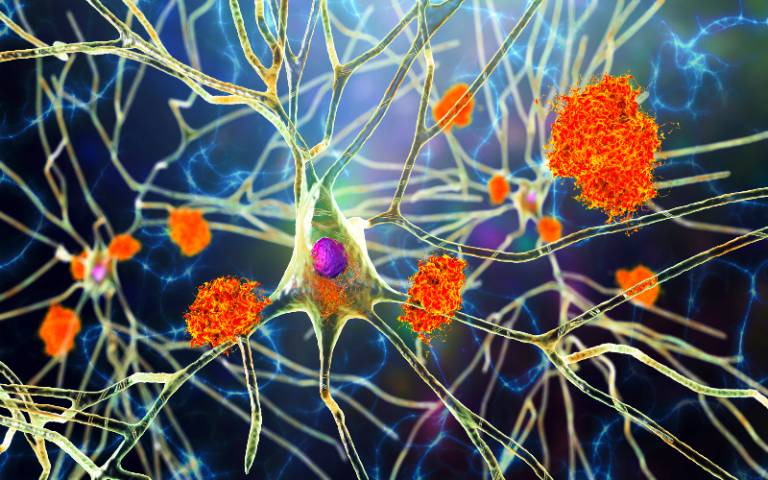New protein linked to early-onset dementia identified
20 December 2023
A first potential therapeutic target for a type of early-onset dementia has been established by a team of scientists, including UCL researchers.

The new study, published in Nature, and led by the Medical Research Council (MRC) Laboratory of Molecular Biology in Cambridge, identified abnormal aggregates of a protein called TAF15 in the brains of individuals with early-onset dementia, known as frontotemporal dementia, where the cause was not previously known.
In most neurodegenerative diseases, including dementias, there’s a common issue where proteins aggregate to form amyloids. Researchers have previously identified the proteins that aggregate in most of these diseases, allowing them to target these proteins for diagnostic tests and treatments.
However, in around 10% of cases of frontotemporal dementia, scientists had yet to identify the rogue protein. Now, a team of researchers have pinpointed aggregated structures of the protein TAF15 in these cases.
The team hope that this could help provide a target for the future development of diagnostic tests and treatments.
Frontotemporal dementia results from the degeneration of the frontal and temporal lobes of the brain, which control emotions, personality and behaviour, as well speech and understanding of words. It tends to start at a younger age than Alzheimer's disease, often being diagnosed in people aged 45 to 65, although it can also affect younger or older people.
Dr Benjamin Ryskeldi-Falcon, who led the study at the MRC Laboratory of Molecular Biology, said: “This discovery transforms our understanding of the molecular basis of frontotemporal dementia. It is a rare finding of a new member of the small group of proteins known to aggregate in neurodegenerative disease.
“Now that we have identified the key protein and its structure, we can start to target it for the diagnosis and therapy of this type of frontotemporal dementia, similar to strategies already in the pipeline for targeting the aggregates of amyloid-beta and tau proteins that characterise Alzheimer's disease.”
The scientists used cutting-edge cryo-electron microscopy (cryo-EM) to study protein aggregates from the brains of four people who had this type of frontotemporal dementia at a very detailed level – down to the individual atoms.
In this type of dementia, scientists had long thought that a protein called FUS aggregated, based on similarities with other neurodegenerative diseases.
However, after using cry-EM, the researchers at the MRC Laboratory of Molecular Biology were able to identify that the protein aggregates from each brain had the same atomic structure. Surprisingly, the protein was not FUS – it was another protein called TAF15.
The donated brains were identified by Professor Tammaryn Lashley (UCL Queen Square Institute of Neurology) and Professor Bernardino Ghetti (Indiana University School of Medicine).
Professor Lashley said: "While we initially believed that FUS was the culprit in the aggregation of proteins associated with frontotemporal dementia, this study, utilising cryo-electron microscopy, revealed a surprising twist. It identified the protein responsible for abnormal aggregates in the brains of individuals with early-onset dementia to be TAF15, not FUS.
"This unexpected finding, identified from brain tissue of FTLD-FUS cases, underscores the critical importance of understanding the molecular intricacies underlying neurodegenerative diseases. This newfound knowledge of TAF15's structure, will open doors to targeted diagnostics and therapeutic interventions."
First author, Dr Stephan Tetter (MRC Laboratory of Molecular Biology), said: “This is an unexpected result because, before this study, TAF15 was not known to form amyloid filaments in neurodegenerative diseases and no structures of the protein existed. Cry-EM is transforming our understanding of the molecular pathology of dementia and neurodegenerative diseases more broadly by giving us insights that were beyond the capabilities of previous technologies.”
Some people who have frontotemporal dementia also have motor neurone disease, a condition in which individuals progressively lose control over their muscles. In this study, two of the individuals who donated their brains had signs of both diseases. For these individuals, the researchers identified the same aggregated structure of TAF15 in brain regions associated with motor neurone disease.
Dr Ryskeldi-Falcon said: “The presence of the same TAF15 aggregates in two individuals who had frontotemporal dementia and signs of motor neurone disease raises the possibility that TAF15 may contribute to both diseases. We are now studying whether aberrant aggregated TAF15 is present in people who have motor neurone disease in the absence of frontotemporal dementia.”
This study was funded by the Medical Research Council, Alzheimer’s Research UK, the US National Institutes of Health, the Alzheimer’s Society, the Association for Frontotemporal Degeneration, the Swiss National Science Foundation, and the Leverhulme Trust.
Dr Charlotte Durkin, Head of the Medical Research Council’s Molecular and Cellular Medicine Board, said: “Decades of world-leading research at the MRC Laboratory of Molecular Biology brought the breakthrough of cryoelectron microscopy - gaining Dr Richard Henderson a Nobel Prize in 2017.
"This latest study identifying the protein linked to a type of frontotemporal dementia continues the MRC LMB’s success in elucidating dementia-related protein structures by cryoEM, which includes the first structure for the key dementia protein tau. Knowing the identity and basic structure of these filaments in this rare form of early-onset dementia is vital to developing early diagnostic tests and drugs to combat their formation.”
Links
- Research in Nature
- Professor Tammaryn Lashley's academic profile
- UCL Queen Square Institute of Neurology
- UCL Brain Sciences
Image
- Credit: Dr_Microbe on iStock
Media contact
Poppy Tombs
E: p.danby [at] ucl.ac.uk
 Close
Close

